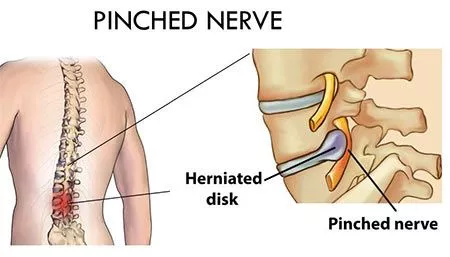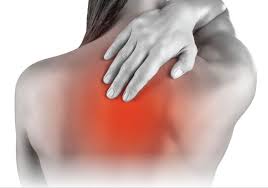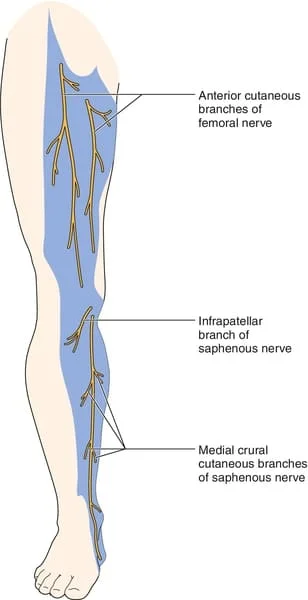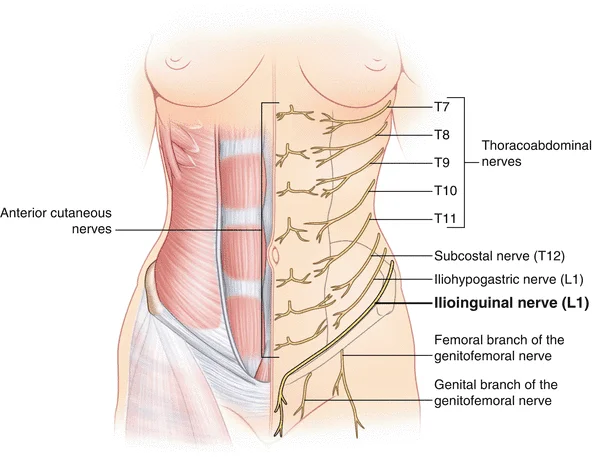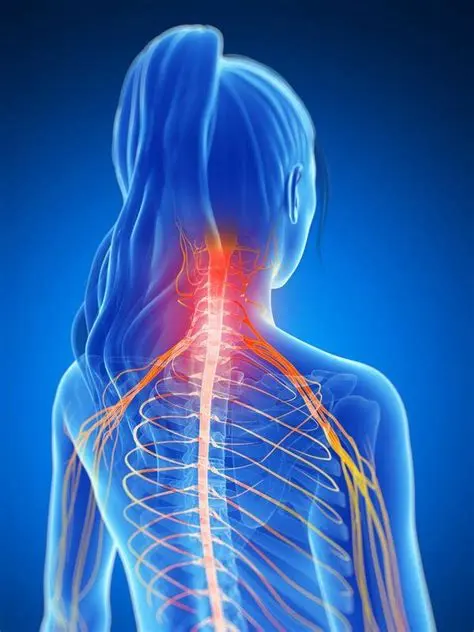A pinched nerve in the low back
Table of Contents
Introduction
- A pinched nerve in your lower back happens because of pressure on the nerves close to the vertebrae in the spine. You may notice a range of symptoms, involving sharp pain and numbness.
- A pinched nerve in your lower back happens when there is excessive pressure on the nerves near the last five vertebrae in your back. This condition can be painful and may gently impact your overall quality of life.
- If you are experiencing ongoing pain in your lower back despite rest, it is important to see your doctor for a proper diagnosis.
What are the symptoms of a pinched nerve in the low back?
- There are so many symptoms you may experience with a pinched nerve in your lower back, involving sharp pain and numbness. The pains may come and go, making stabbing sensations.
Additionally, you may experience:
- Muscle weakness
- muscle spasms
- reflex loss
Sciatica
- Sciatica describes symptoms that relate to matters with the sciatic nerve that extends between your lower back and feet. When the sciatic nerve is either harmed or compressed, you may experience sciatica.
Sciatica causes sharp pain, tingling, numbness, and weakness that may happen in the following areas:
- lower back
- hips
- buttocks
- legs
- feet and ankles.
- Symptoms of sciatica tend to worsen when you create sudden movements, such as sneezing. The pain may be important enough to interfere with everyday movements, such as walking.
- Additionally, you may experience tingling sensations between your lower back and ankles that feel such as “pins and needles.”
- As a rule of thumb, if you have pain in the lower back only, you such as do not have sciatica.
What might cause a pinched nerve in the low back?
- A pinched nerve in your back may seemingly look out of nowhere, or it could be the result of a traumatic injury, such as a fall.
- You are more likely to experience symptoms if you are middle ages 30 and 50. This is because your vertebrae press with age, and the discs in your vertebrae degenerate over time.
- One more usual cause of the pinched nerve in the lower back is a herniated disc. You may experience this condition because of aging, a find in your vertebrae, or wear and tear. Men age 20 to 50 are at a greater risk of developing a herniated disc.
Other possible causes of a pinched nerve in the lower back involve:
- Disc prolapse (PIVD)
- spinal stenosis
- bone spur formation (osteophytes)
- lumbar spondylolisthesis
- foraminal stenosis
- degeneration
- rheumatoid arthritis.
What are the risk factors for the pinched nerve?
Aside from usual wear-and-tear with age, other risk factors could contribute to a pinched nerve in the lower back, such as:
- poor posture, especially from computer work
- not getting enough regular exercise
- improper lifting
- repetitive movements
- overweight or obese
- smoking.
How is the pinched nerve in the back diagnosed?
- Your doctor will 1st ask you about your symptoms. It is important to provide as many details as you can, such as how long you have been experiencing pain and discomfort, how it is harming your quality of life, and whether you have recently experienced any current injuries.
Next, your doctor will see for physical signs of trauma or other problems in your low back by checking for possible:
- limited range of motion
- balance problems
- changes to reflexes in your legs
- weakness in the muscles
- changes in sensation in the lower extremities.
- Your doctor may not be clear to diagnose the pinched nerve from a physical examination alone. Additionally, they may want to understand further the cause of the pinched nerve.
They may order the following tests to require more information:
- X-ray: looks at the bones in your vertebrae.
- MRI looks at your soft tissues, including the discs in your vertebrae, your spinal cord, and the nerves in your lower back.
- CT scan: looks at a very detailed picture of your lower back and can be used to evaluate bony structures and muscles.
- Such imaging tests are commonly ordered in the case of long-term symptoms only. For example, doctors may not order imaging tests for sciatica except if symptoms last for 12 weeks or more trusted Source.
How is a pinched nerve in the low back treated?
Once your doctor diagnoses the pinched nerve in your lower back, you can start to consider treatment. Options may include a combination of:
- over-the-counter (OTC) pain relievers
- physical therapy
- other lifestyle adjustments.
- Sometimes your doctor will require you to treat a pinched nerve with more invasive measures, such as spinal injections or surgery.
Baseline treatments
- Your doctor will likely prescribe you noninvasive, baseline treatments for your pinched nerve 1st. In most cases, nonsurgical calculates will relieve your symptoms.
- Keep in mind that it can take so many weeks for treatment to take effect before your doctor may consider more invasive treatment options.
Medications
- If your doctor gives you the go-ahead, you may try (over the counter) OTC nonsteroidal anti-inflammatory drugs (NSAIDs) to treat the pinched nerve 1st. These types of medications can lessen inflammation and decrease pain.
- Your doctor may prescribe oral steroids to treat the condition if NSAIDs and other treatments are ineffective.
Home-based remedies
Your doctor may recommend that you make lifestyle modifications to assist with the symptoms of a pinched nerve in your lower back. Some of these treatments may assist in your management plan.
- Activity modification: You may find that some seated positions or activities that cause you to twist or lift make your pinched nerve worse. Your doctor may recommend you keep away from these activities for a period of time to alleviate symptoms.
- Ice and heat: Applying ice or heat for 20 minutes a certain times a day may reduce pain and muscle spasms. If you have recently experienced a low back injury, however, avoid applying heat for 48 hours.
- Frequent movement: Exercising regularly may assist avoid the onset of nerve pain or relieve symptoms. You may also try light yoga or tai chi as forms of light exercise that still assist build strength and flexibility.
- Sleeping position modifications: Your sleeping position may annoy the symptoms of your nerve pain. Discuss the good sleeping position for the pain with your doctor & determine how to practice proper sleeping habits. This may involve adjusting your sleeping position or sleeping with a pillow middle of your legs.
Higher level treatments
- When the baseline treatments for a pinched nerve do not offer relief, your doctor may recommend more aggressive strategies for treatment.
Injectable steroids
- Your doctor may suggest an injectable steroid if your symptoms persist. You can treat serious pain by receiving an epidural injection of steroids in your doctor’s office or under fluoroscopy in an X-ray department. This can relieve swelling and other symptoms in the affected part.
Surgery
- The previous resort for treating a pinched nerve in your lower back is to undergo surgery. There are many surgical methods, and your doctor will suggest a procedure that will target the cause of the condition.
- For example, a herniated disc in your lower back may be managed with a microdiscectomy. This procedure includes a small incision in your back.
- Retain in mind that surgeries come with risks and sometimes long recovery periods, so you will want to try less invasive methods before opting for surgery.
Physiotherapy Treatment
- You may work with a physical therapist to choose the symptoms caused by your pinched nerve. Your physical therapist will supply you with instructions for stretches and exercises that will stabilize your spine.
Stretches and exercises for the pinched nerve in the back
- Always discuss any stretches and exercises you may be considering with your doctor previous you try them. You want to make sure you do not worsen your symptoms or do anything that causes more pain.
- Utilize a yoga mat, towel, or carpet to lie on when engaging in these stretches. You should do 2 to 3 repetitions of these stretches each time, and make sure to take deep breaths while stretching.
- Knees to chest

- Lie on the floor.
- Fold both knees and point them up toward the ceiling. Your feet keep being on the floor.
- Bring your knees up to your chest and grab them there for 10 to 20 seconds.
- Relax your legs and return your feet to the floor in the knees bent position.
- Mobilizing stretch
- Keep the similar inactive position as in the knee-to-chest stretch.
- Rather than bringing your knee to your chest, extend your leg so your foot points to the ceiling — do not point your toe.
- Hold it in the air for 20 to 30 seconds and then relax the hold.
- Same with the other leg.
- Gluteal stretch
- This exercise also begins in a similar position with head support and knees pointed to the ceiling.
- Bring one of your legs up and rest your foot on your other fold leg. The knee of your lifted leg will be perpendicular to your body.
- Hold the thigh that is holding up your foot and pull it toward your chest and head.
- Hold the position for 20 to 30 seconds and relax.
- Same this on the other side of your body.
When to see a doctor?
- Any chronic (ongoing) low back pain ought to be detected by a doctor, especially if your symptoms interfere with your daily activities. By properly diagnosing the pinched nerve and its underlying cause, your doctor can then prescribe you treatments that can assist.
- If you are currently undergoing treatment for a pinched nerve in your lower back, it is also important to look to your doctor if symptoms worsen or do not improve within 4 to 6 weeks.
Outcomes
- There are so many possible treatments for a pinched nerve in your lower back. You will want to try baseline approaches at home previously pursuing more invasive methods of treatment.
- Using NSAIDs, stretching and staying active, and resting your back may be the 1st line of treatment for your condition.
- Make an appointment with a doctor if your pain is persistent or serious.
FAQs
The most often recommended treatment for the pinched nerve is rest for the affected part. Your doctor will tell you to stop any activities that cause or increase the compression. Turning on the location of the pinched nerve, you may require a splint, collar, or brace to immobilize the part.
Numbness or decreased sensation in the part supplied by the nerve. Sharp, aching, and burning pain, which may radiate outer. Tingling, pins, and needles sensations (paresthesia) Muscle weakness in the affected part.
The answer is yes! By applying pressure to the pinched nerve, it can assist relieve tension, decreasing pain, and inflammation, and promoting circulation. It will also assist relax you, your muscles, and the affected part as well.
Pinched nerves commonly require better in three to four days. However, if home care does not seem to help, you may require to look for a medical expert. If the pressure on the nerve is not relieved in a less amount of time, the nerve damage may become permanent, causing chronic pain and muscle weakness.
If your muscles are strained, they will feel such as a sore or tight ache. A pulled muscle would not feel hot, tingling, or electric such as an irritated nerve root would. The pain would only subside while you are released and resting, as the tension and spasms are alleviated.
A nerve pinched in the lower back can start pain in the lower back, buttocks, and legs. In most cases, pinched nerves go away in their individual with over-the-counter pain medication and rest. However, in infrequent cases, they can worsen, causing permanent nerve damage and chronic pain.
Pain in the part of compression, such as the neck or low back. Radiating pain, like sciatica or radicular pain. Numbness or tingling. “Pins and needles” or a burning sensation.

